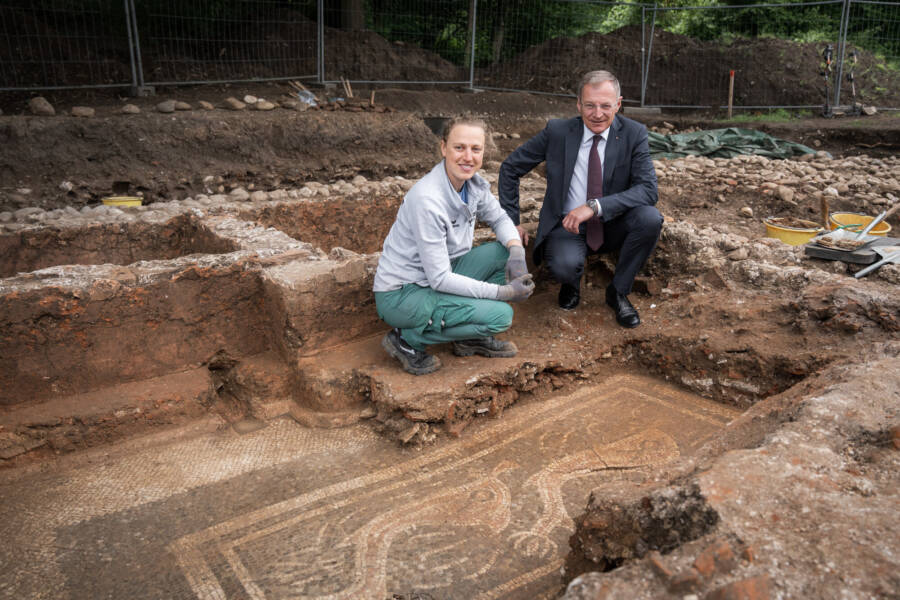The dolphin mosaic likely dates to the second century C.E. and was part of a villa owned by a wealthy Roman family.

OÖ Landes-Kultur GmbH/FacebookRoman floor mosaics like these are incredibly rare in Austria.
During excavations at Thalheim bei Wels, Austria, archaeologists came across the ruins of a sprawling Roman villa from the second century C.E. Within the villa, they’ve unearthed three floor mosaics — including one that shows a pair of dolphins swimming through the waves.
An incredibly rare find for Austria, the mosaics hint at the immense wealth of the Roman family who once owned the villa where they were discovered.
The ‘Spectacular Discovery’ Of The Dolphin Mosaic

OÖ Landes-Kultur GmbH/FacebookExcavations of the villa on Reinberg Hill in Thalheim bei Wels have revealed a number of stunning floor mosaics.
According to a press release from the University of Salzburg, the dolphin mosaic was found during excavations of an immense Roman villa complex on Reinberg Hill in Thalheim bei Wels, once the site of the Roman city Ovilava.
The excavation project, led by archaeologists from the University of Salzburg and the Upper Austrian State Cultural Heritage Association, began in 2023 and has uncovered three mosaics so far. After finding the first one in 2024, archaeologists unearthed two more this year. One depicts “a large vessel with curved handles and a wide opening” that ancient Romans would have used to hold wine during feasts. The other is a set of geometric patterns. And the third mosaic shows two dolphins swimming in the waves.
Though Roman mosaics with dolphins have been found in England and Turkey in recent years, archaeologists note that such a floor mosaic is an “absolute rarity” for Upper Austria.
“We expected to find a mosaic because last year’s excavation campaign uncovered a mosaic depicting a vessel with ivy tendrils,” excavation director Felix Lang of the University of Salzburg told All That’s Interesting in an email. “But such a well-preserved dolphin mosaic is extraordinary. It was a very special, exciting moment.”

OÖ Landes-Kultur GmbH/FacebookArchaeologists with the dolphin mosaic, which has been described as an “absolute rarity” in Upper Austria.
Some mosaics have been found on the other side of the Traun River, Lang added, but none “with a figurative representation and in such a good state of preservation.”
Archaeologists believe that the mosaics date back to the second century C.E., a time when the area was known as the Roman city of Ovilava.
The Ongoing Excavations Of Ovilava
As the press release notes, the three mosaics were found during the larger excavation of a sprawling Roman villa on Reinberg Hill.
“[T[he size of the complex [is] remarkable,” the press release states. “The ruins recorded so far cover an area of more than [10,000 square feet].”
The sprawling villa decorated with mosaics and perched on the hill likely once belonged to a prominent and wealthy family.
“The family certainly belonged to the upper class in the region and was represented in the city council of the Ovilava colonia,” Lang explained to All That’s Interesting. “Some members of this family may also have been mayors (duumviri iure dicundo) of Ovilava.”

OÖ Landes-Kultur GmbH/FacebookIn addition to the dolphin mosaic, archaeologists also found a mosaic featuring a “large vessel” used to mix wine and one with geometric patterns.
According to the Princeton Encyclopedia of Classical Sites, Ovilava, known today as Wels, once played a small but prominent role on the outskirts of the Roman Empire. It was an important crossroads located at the junction of several important roads, as well as the crossing of the Traun River.
Several prominent Roman emperors had administrative dealings with Ovilava: Hadrian bestowed a municipal constitution (municipium Aelium Ovilava) on the city, Marcus Aurelius transferred offices to Ovilava during wars between the Romans and the Germanic Marcomanni people, and Caracalla elevated the standing of the city to a colonia and likely fortified it against the threat of attacks from Germanic tribes.
However, Ovilava was eventually run over by these attacks and later abandoned. As such, many of its Roman treasures were lost — and are still being uncovered.
“The mosaics of Thalheim near Wels,” noted Governor Thomas Stelzer, “show once again what wonderful cultural treasures are still hidden.”
Indeed, the discovery of the dolphin mosaic and the larger Roman villa are a fascinating piece of Upper Austria’s Roman history. Buried for centuries, they’re an example of the far reaches of the Roman Empire, and they tell a story about how its wealthiest inhabitants once lived.
Archaeologists are hopeful that further excavations will reveal even more Roman treasures, and they noted in the university press release: “What will the investigations reveal in the unexplored areas surrounding the mosaics, and what might this part of the Roman villa have served?”
After reading about the dolphin mosaic found in Upper Austria, discover the complicated story of the long decline and eventual collapse of the Roman Empire. Or, learn the wild stories of some of the worst Roman emperors.





